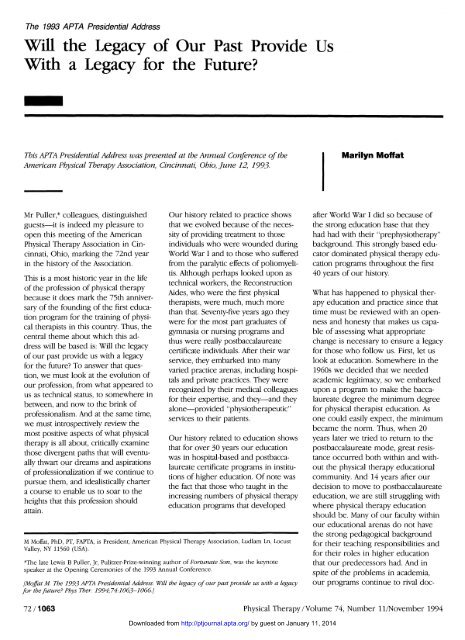Will the Legacy of Our Past Provide Us With a ... - Physical Therapy
Will the Legacy of Our Past Provide Us With a ... - Physical Therapy
Will the Legacy of Our Past Provide Us With a ... - Physical Therapy
You also want an ePaper? Increase the reach of your titles
YUMPU automatically turns print PDFs into web optimized ePapers that Google loves.
The 1993 APTA Presidential Address<br />
<strong>Will</strong> <strong>the</strong> <strong>Legacy</strong> <strong>of</strong> <strong>Our</strong> <strong>Past</strong> <strong>Provide</strong> <strong>Us</strong><br />
<strong>With</strong> a <strong>Legacy</strong> for <strong>the</strong> Future?<br />
This APTA Presidential Address was presented at <strong>the</strong> Annual Conference <strong>of</strong> <strong>the</strong><br />
American <strong>Physical</strong> <strong>Therapy</strong> Association, Cincinnati, Ohio, fune 12, 1993-<br />
Marilyn M<strong>of</strong>fat<br />
Mr Puller,* colleagues, distinguished<br />
guests—it is indeed my pleasure to<br />
open this meeting <strong>of</strong> <strong>the</strong> American<br />
<strong>Physical</strong> <strong>Therapy</strong> Association in Cincinnati,<br />
Ohio, marking <strong>the</strong> 72nd year<br />
in <strong>the</strong> history <strong>of</strong> <strong>the</strong> Association.<br />
This is a most historic year in <strong>the</strong> life<br />
<strong>of</strong> <strong>the</strong> pr<strong>of</strong>ession <strong>of</strong> physical <strong>the</strong>rapy<br />
because it does mark <strong>the</strong> 75th anniversary<br />
<strong>of</strong> <strong>the</strong> founding <strong>of</strong> <strong>the</strong> first education<br />
program for <strong>the</strong> training <strong>of</strong> physical<br />
<strong>the</strong>rapists in this country. Thus, <strong>the</strong><br />
central <strong>the</strong>me about which this address<br />
will be based is: <strong>Will</strong> <strong>the</strong> legacy<br />
<strong>of</strong> our past provide us with a legacy<br />
for <strong>the</strong> future? To answer that question,<br />
we must look at <strong>the</strong> evolution <strong>of</strong><br />
our pr<strong>of</strong>ession, from what appeared to<br />
us as technical status, to somewhere in<br />
between, and now to <strong>the</strong> brink <strong>of</strong><br />
pr<strong>of</strong>essionalism. And at <strong>the</strong> same time,<br />
we must introspectively review <strong>the</strong><br />
most positive aspects <strong>of</strong> what physical<br />
<strong>the</strong>rapy is all about, critically examine<br />
those divergent paths that will eventually<br />
thwart our dreams and aspirations<br />
<strong>of</strong> pr<strong>of</strong>essionalization if we continue to<br />
pursue <strong>the</strong>m, and idealistically charter<br />
a course to enable us to soar to <strong>the</strong><br />
heights that this pr<strong>of</strong>ession should<br />
attain.<br />
<strong>Our</strong> history related to practice shows<br />
that we evolved because <strong>of</strong> <strong>the</strong> necessity<br />
<strong>of</strong> providing treatment to those<br />
individuals who were wounded during<br />
World War I and to those who suffered<br />
from <strong>the</strong> paralytic effects <strong>of</strong> poliomyelitis.<br />
Although perhaps looked upon as<br />
technical workers, <strong>the</strong> Reconstruction<br />
Aides, who were <strong>the</strong> first physical<br />
<strong>the</strong>rapists, were much, much more<br />
than that. Seventy-five years ago <strong>the</strong>y<br />
were for <strong>the</strong> most part graduates <strong>of</strong><br />
gymnasia or nursing programs and<br />
thus were really postbaccalaureate<br />
certificate individuals. After <strong>the</strong>ir war<br />
service, <strong>the</strong>y embarked into many<br />
varied practice arenas, including hospitals<br />
and private practices. They were<br />
recognized by <strong>the</strong>ir medical colleagues<br />
for <strong>the</strong>ir expertise, and <strong>the</strong>y—and <strong>the</strong>y<br />
alone—provided "physio<strong>the</strong>rapeutic"<br />
services to <strong>the</strong>ir patients.<br />
<strong>Our</strong> history related to education shows<br />
that for over 30 years our education<br />
was in hospital-based and postbaccalaureate<br />
certificate programs in institutions<br />
<strong>of</strong> higher education. Of note was<br />
<strong>the</strong> fact that those who taught in <strong>the</strong><br />
increasing numbers <strong>of</strong> physical <strong>the</strong>rapy<br />
education programs that developed<br />
M M<strong>of</strong>fat, PhD, PT, FAPTA, is President, American <strong>Physical</strong> <strong>Therapy</strong> Association, Ludlam Ln, Locust<br />
Valley, NY 11560 (USA).<br />
*The late Lewis B Puller, Jr, Pulitzer-Prize-winning author <strong>of</strong> Fortunate Son, was <strong>the</strong> keynote<br />
speaker at <strong>the</strong> Opening Ceremonies <strong>of</strong> <strong>the</strong> 1993 Annual Conference.<br />
[M<strong>of</strong>fat M. The 1993 APTA Presidential Address. <strong>Will</strong> <strong>the</strong> legacy <strong>of</strong> our past provide us with a legacy<br />
for <strong>the</strong> future? Phys Ther. 1994,74.1063-1066]<br />
after World War I did so because <strong>of</strong><br />
<strong>the</strong> strong education base that <strong>the</strong>y<br />
had had with <strong>the</strong>ir "prephysio<strong>the</strong>rapy"<br />
background. This strongly based educator<br />
dominated physical <strong>the</strong>rapy education<br />
programs throughout <strong>the</strong> first<br />
40 years <strong>of</strong> our history.<br />
What has happened to physical <strong>the</strong>rapy<br />
education and practice since that<br />
time must be reviewed with an openness<br />
and honesty that makes us capable<br />
<strong>of</strong> assessing what appropriate<br />
change is necessary to ensure a legacy<br />
for those who follow us. First, let us<br />
look at education. Somewhere in <strong>the</strong><br />
1960s we decided that we needed<br />
academic legitimacy, so we embarked<br />
upon a program to make <strong>the</strong> baccalaureate<br />
degree <strong>the</strong> minimum degree<br />
for physical <strong>the</strong>rapist education. As<br />
one could easily expect, <strong>the</strong> minimum<br />
became <strong>the</strong> norm. Thus, when 20<br />
years later we tried to return to <strong>the</strong><br />
postbaccalaureate mode, great resistance<br />
occurred both within and without<br />
<strong>the</strong> physical <strong>the</strong>rapy educational<br />
community. And 14 years after our<br />
decision to move to postbaccalaureate<br />
education, we are still struggling with<br />
where physical <strong>the</strong>rapy education<br />
should be. Many <strong>of</strong> our faculty within<br />
our educational arenas do not have<br />
<strong>the</strong> strong pedagogical background<br />
for <strong>the</strong>ir teaching responsibilities and<br />
for <strong>the</strong>ir roles in higher education<br />
that our predecessors had. And in<br />
spite <strong>of</strong> <strong>the</strong> problems in academia,<br />
our programs continue to rival doc-<br />
72/1063<br />
<strong>Physical</strong> <strong>Therapy</strong>/Volume 74, Number 11/November 1994<br />
Downloaded from http://ptjournal.apta.org/ by guest on January 11, 2014
















